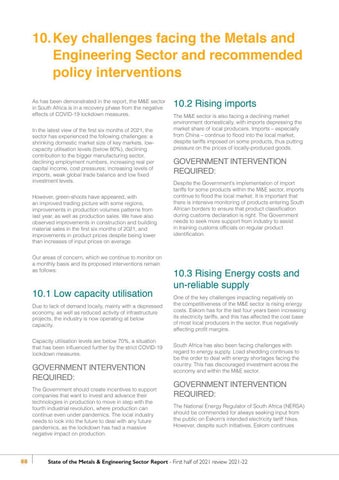10. Key challenges facing the Metals and Engineering Sector and recommended policy interventions As has been demonstrated in the report, the M&E sector in South Africa is in a recovery phase from the negative effects of COVID-19 lockdown measures. In the latest view of the first six months of 2021, the sector has experienced the following challenges: a shrinking domestic market size of key markets, lowcapacity utilisation levels (below 80%), declining contribution to the bigger manufacturing sector, declining employment numbers, increasing real per capital income, cost pressures; increasing levels of imports, weak global trade balance and low fixed investment levels. However, green-shoots have appeared, with an improved trading picture with some regions, improvements in production volumes patterns from last year, as well as production sales. We have also observed improvements in construction and building material sales in the first six months of 2021, and improvements in product prices despite being lower than increases of input prices on average. Our areas of concern, which we continue to monitor on a monthly basis and its proposed interventions remain as follows:
10.1 Low capacity utilisation Due to lack of demand locally, mainly with a depressed economy, as well as reduced activity of infrastructure projects, the industry is now operating at below capacity. Capacity utilisation levels are below 70%, a situation that has been influenced further by the strict COVID-19 lockdown measures.
GOVERNMENT INTERVENTION REQUIRED: The Government should create incentives to support companies that want to invest and advance their technologies in production to move in step with the fourth industrial revolution, where production can continue even under pandemics. The local industry needs to look into the future to deal with any future pandemics, as the lockdown has had a massive negative impact on production.
88
10.2 Rising imports The M&E sector is also facing a declining market environment domestically, with imports depressing the market share of local producers. Imports – especially from China – continue to flood into the local market, despite tariffs imposed on some products, thus putting pressure on the prices of locally-produced goods.
GOVERNMENT INTERVENTION REQUIRED: Despite the Government’s implementation of import tariffs for some products within the M&E sector, imports continue to flood the local market. It is important that there is intensive monitoring of products entering South African borders to ensure that product classification during customs declaration is right. The Government needs to seek more support from industry to assist in training customs officials on regular product identification.
10.3 Rising Energy costs and un-reliable supply One of the key challenges impacting negatively on the competitiveness of the M&E sector is rising energy costs. Eskom has for the last four years been increasing its electricity tariffs, and this has affected the cost base of most local producers in the sector, thus negatively affecting profit margins. South Africa has also been facing challenges with regard to energy supply. Load shedding continues to be the order to deal with energy shortages facing the country. This has discouraged investment across the economy and within the M&E sector.
GOVERNMENT INTERVENTION REQUIRED: The National Energy Regulator of South Africa (NERSA) should be commended for always seeking input from the public on Eskom’s intended electricity tariff hikes. However, despite such initiatives, Eskom continues
State of the Metals & Engineering Sector Report - First half of 2021 review 2021-22













